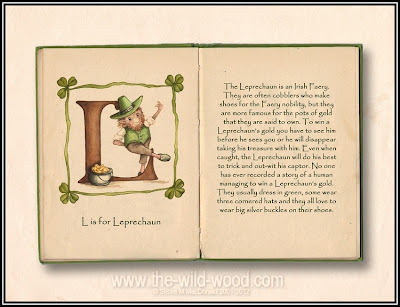There can be few people in the Western world who haven't heard of Leprechauns. Along with the shamrock they have become something of a national symbol in Ireland. St. Patrick's day celebrations are awash with people in green costumes and red beards. Their pots of gold are also legendary. To win one you have to catch the Leprechaun first which is no easy feat as they will disappear as soon as they see you unless you've seen them first. Once spied and 'caught' in your gaze, the Leprechaun will likely bargain his treasure to secure his release. But be warned - many Faery Folk are able to cast glamours and you may well find that the pot of gold becomes nothing more than a pot of dead leaves by morning!
 |
| © Shona M MacDonald 2012 All Rights Reserved |
As promised, the rest of this post is a brief walkthrough of how I've created the pages of the Enchanted Alphabet.
The illustrations themselves are created traditionally. So, I started with a couple of sketches. One was of a Leprechaun making a shoe, the other dancing with his pot of gold. I wasn't completely happy with the first one so it was the second sketch that I used.
Next I drew out the border and the letter L onto a 5"x7" piece of hot-pressed watercolour paper. I prefer using hot-pressed paper to cold-pressed as it's smoother so you can add small details more easily. Once this was done, I transferred the sketch to the paper using a sheet of graphite paper. A tip taught to me by my tutor on the botanical illustration course I did a couple of years ago was to use the tip of a dart or, in my case, the point of a pair of compasses to trace the outline of the image so that you get nice, clean, narrow lines. Once this was done I added a pale wash of watercolour to the border and the letter. As you can see, the lines created by the tracing are so faint that didn't even show up in the scan:
I continued to work on the letter and the border, darkening down the areas, adding some definition to the shamrock leaves and shading to the letter:
Then I started working on the Leprechaun and his gold in the same way. I used light washes first to define the different areas, then began to add shading and more detail:
Until finally the image was complete:
Next came the digital bit. If you know all about digital art then please bear with me on this as I'm just learning to find my way around the most basic bits of Photoshop Elements :)
To create the book pages I scanned the cover and pages of a real book that I bought at a local flea market then removed the text and illustrations before replacing them with my own.
After scanning a page I used the clone brush tool to get rid of the text and illustrations. In the pic below you can see that I've started to do this:
And here it is when I finished:
Typical me, I decided that I wanted the book to have a green cover (green is a good faery colour) so I had to carefully 'select' all the visible areas of the cover and adjust the hue and saturation of the selected area to make it green, then I used the background eraser tool to make the area around the book transparent (it shows up white in the jpeg below, but in Photoshop, as a .psd it's transparent):
So my page is ready for its new text and illustration. The illustration was added on a separate layer, reduced to the right size and moved into place. I chose a 'blend mode' of 'multiply' for this layer so that the book page underneath would show through:
Then I added the text using the text tool. Finally, I added a background behind the whole thing and created a shadow behind the book to make it look more real:
M is next, then I better get painting again as N is one of the letters I've yet to complete!!













